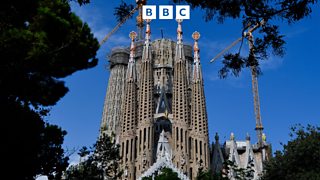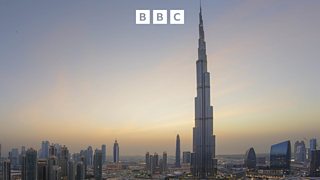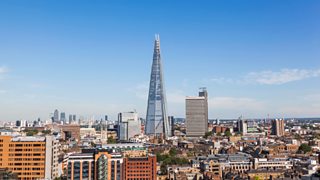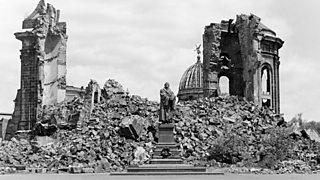Five moments from the history of La Sagrada Familia
La Sagrada Familia is Barcelona’s famous unfinished church.
Vicky Farncombe from Witness History has been talking to architect Mark Burry, who worked on the building for more than 35 years, about some of the key moments from its history.
1. Family values
The idea of building a church that represented family values was first suggested in the late 1800s as Barcelona was expanding and becoming a more wealthy city.
The cornerstone was laid in March 1882 and Antoni Gaudi took over as chief architect the following year.
His idea was that the church would have three grand exterior faces, each depicting a phase in the life of Jesus: The Nativity - dedicated to His birth; The Passion - representing His death and resurrection; and The Glory, the main facade of the building, symbolising Heaven and the afterlife.
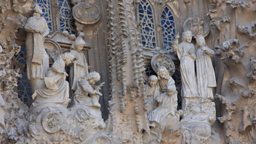
(Photo: La Sagrada. Credit: ±«Óătv)
2. Gaudi's death
Gaudi worked on the building for 42 years, even creating a makeshift home in his workshop so he could spend every waking hour there.
He even had a live braying donkey winched up the side"
±«Óătv presenter Stephen Smith, who visited the church in 2011, described how obsessive Gaudi was about getting the details right.
“He had turkeys anaesthetised so he could make plaster casts of them and see how they'd look up here,” he said.
“He even had a live braying donkey winched up the side of the basilica just to get the perspective on how that might look in his nativity scene.”
But Gaudi died unexpectedly in 1926 after being run over by a tram.
At the time, he'd only managed to complete a quarter of the church – the Nativity façade.
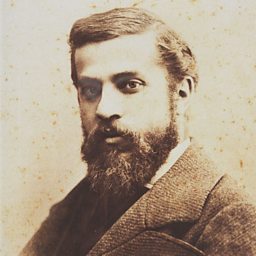
(Photo: Antoni Gaudi. Credit: Getty Images)
3. Spanish Civil War
Gaudi had made contingency plans for his death - leaving detailed drawings and huge 3D, plaster of Paris models for his disciples to follow.
But 10 years after he died, they were destroyed during the Spanish Civil War.
Mark Burry, professor of Urban Futures at Swinburne University of Technology, in Melbourne, first saw the church in 1977 and ended up joining the team of architects trying to piece together Gaudi’s vision from the broken bits.
“There were literally thousands and thousands of pieces and lots of missing pieces,” he said.
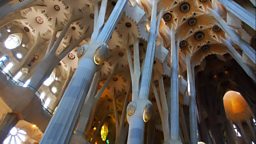
(Photo: Inside La Sagrada Familia. Credit: Getty Images)
4. Bringing Gaudi’s vision to life
Over the next four decades, Mark and his colleagues painstakingly put together the church nave - the central part where the congregation sits - as well as the Passion facade and the Glory facade.
Along with the broken model pieces, they had photographs and mathematical models to help them.
The ±«Óătv’s Stephen Smith was impressed by their work.
“You can't help but be awed by its majesty, its size and its slight kookiness,” he said.
“It's got a futuristic feel in a 70s way. It's like the first cathedral on Mars.”
But not everyone thought finishing the church was the right thing to do.
One objector was the late British architect David Mackay who was interviewed by the ±«Óătv in 1999.
“It doesn't really make much sense to continue it. It's like someone completing Picasso after Picasso died.
“Every time I go by, I almost feel like vomiting.”
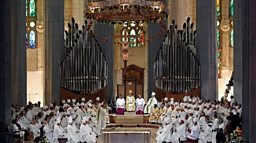
(Photo: Pope Benedict consecrates La Sagrada Familia. Credit: Getty Images)
5. Pope blessing
Working at the site day in, day out, surrounded by scaffolding, Mark rarely got to appreciate the work he and his colleagues had achieved.
But when the church was consecrated in 2010, by Pope Benedict, he realised how far they'd come.
“That’s when it really hit me because I was seeing the building in use for the first time,” he said.
“And of course, that was the first time ever we heard music in the space.
“Every hair on the body sort of stood up.”
More architecture stories from Witness History
-
![]()
Burj Khalifa: Designing the world’s tallest building
The tallest building in the world opened in 2010. There was a glitzy firework display to celebrate the occasion
-
![]()
Hitler's Architect
Albert Speer was Hitler's architect and friend
-
![]()
The Shard
The building of the controversial London skyscraper, designed by Italian Renzo Piano
-
![]()
The church that rose from the rubble
The story of the painstaking project to reconstruct Dresden's historic baroque church
